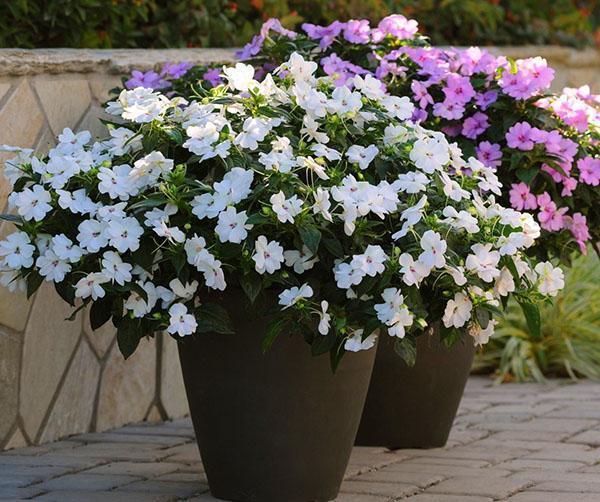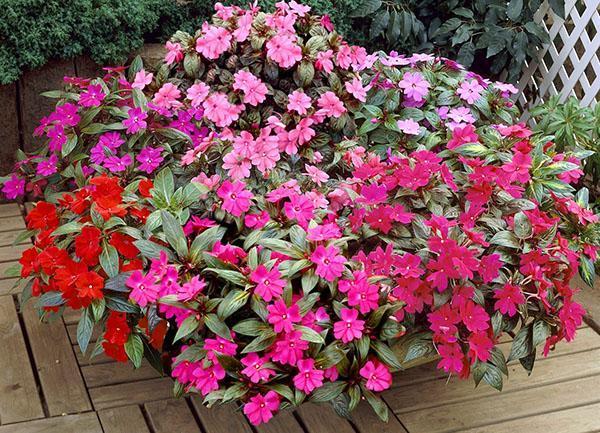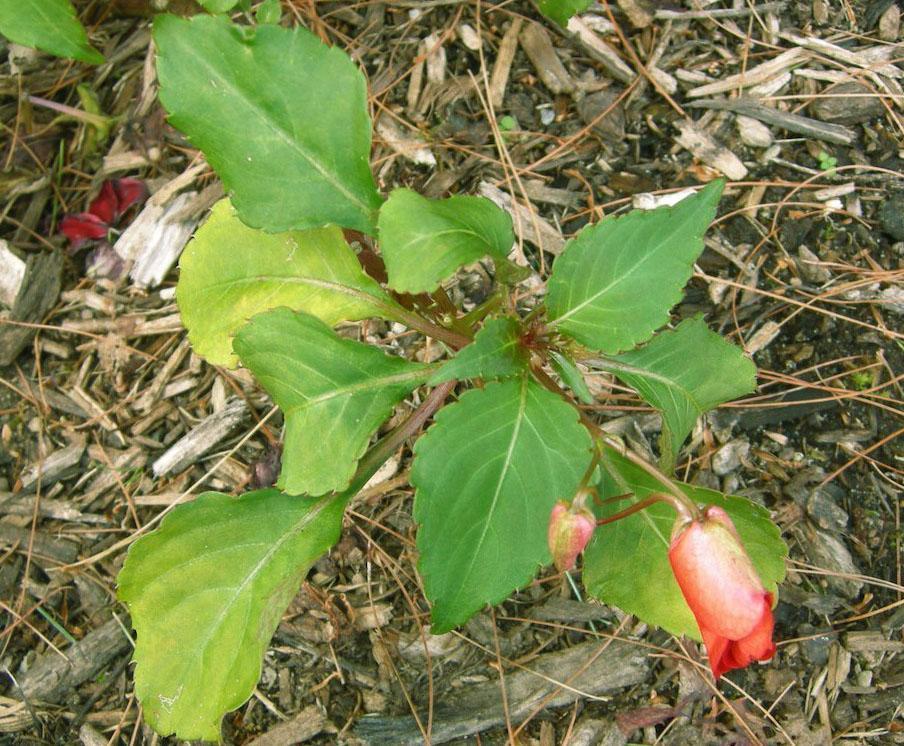Diseases and pests of the balsam flower
 Fast growing, almost continuously flowering and always dressy balsams are considered one of the best indoor plants for budding growers. Bright touch-sensitive lights that still delighted our grandmothers, and today they are welcome residents of window sills, loggias and garden plots. They respond to simple care with the formation of new buds and the shine of the foliage.
Fast growing, almost continuously flowering and always dressy balsams are considered one of the best indoor plants for budding growers. Bright touch-sensitive lights that still delighted our grandmothers, and today they are welcome residents of window sills, loggias and garden plots. They respond to simple care with the formation of new buds and the shine of the foliage.
But even this unpretentious plant sometimes becomes a victim of insect pests and pathogens of various diseases. What are the dangers of balsam flower? How to identify them, and, if necessary, provide treatment for ornamental plants?
Most often, the reasons for the weakening of a green pet, its wilting or cessation of growth are non-compliance with the required conditions of detention or lack of attention. In nature, balsams live in regions with a warm, fairly humid climate, where there are no sudden changes in temperature and, moreover, frost.

It is not for nothing that the balsam has been called Vanka Wet from ancient times. Plants are not only extremely critical of soil drying, but also love moist air.
Asking the question: "Why do the leaves fall off the balsam?", The grower must analyze the conditions in which the flower is. Operating heating devices affect both the room temperature and the air humidity. The lower it is, the stronger the evaporation of moisture from the leaves, and the balsam weakens faster. Frequent drying out of the soil leads to this, especially during active growth.
 As a result, flowering and growth of new shoots are inhibited, and the leaves, starting from the lower ones, turn yellow and fall off. Insects and ticks often use this situation.
As a result, flowering and growth of new shoots are inhibited, and the leaves, starting from the lower ones, turn yellow and fall off. Insects and ticks often use this situation.
An excessive drop in air temperature is also an unfavorable factor. Balsam does not tolerate even short-term cooling, therefore it is better to clean the plants taken out into the garden or on the balcony from the second half of summer at night.
Balsam diseases and their treatment
At low temperatures, the need for moisture decreases, so watering must be reduced. If this is not done, you cannot avoid the appearance of rot, others, as in the photo, diseases and pests of balsam.
 Among the diseases of balsam, the greatest harm to plants outdoors is caused by downy mildew.
Among the diseases of balsam, the greatest harm to plants outdoors is caused by downy mildew.
Several years ago, a real epidemic of this disease hit the balsams in the United States. The development of the infection was facilitated by:
- cool wet weather;
- crowded plantings, in which moisture does not have time to evaporate from the soil surface;
- insufficient attention to plant care.
The first signs of the disease caused by harmful fungi appear at temperatures below 16-18 ° C at 100% humidity. The causative agents of the disease with moisture permeate the tissue of the leaves, and after a couple of days a healthy balsam flower is transformed. First, a whitish bloom appears on the back of the leaves, then they turn black and fall off.
 New foliage becomes smaller, or growth stops altogether.As a result, only non-viable remnants of shoots remain from the flowering balsam. To prevent the death of plants, during a cold snap:
New foliage becomes smaller, or growth stops altogether.As a result, only non-viable remnants of shoots remain from the flowering balsam. To prevent the death of plants, during a cold snap:
- reduce the frequency of watering;
- protect balsams from falling out of cold dew;
- take measures to ventilate the room.
At the first signs of the disease, all balsams affected by the disease are removed, and the plants are treated with systemic fungicides without visible damage.
 Balsams, forced to grow in excessively moist soil, often become victims of putrefactive bacteria.
Balsams, forced to grow in excessively moist soil, often become victims of putrefactive bacteria.
An additional factor contributing to the spread of dangerous fungi and microorganisms is low air temperature. In such conditions, plants need less moisture, their metabolic processes and growth slow down.
Rot affects the stems in contact with the ground, as well as leaves and other parts of the plant. An infected shoot or leaf stalk turns brown, becomes thinner and dies off. The greatest attention should be paid to balsam disease and its treatment if traces of gili are found on young specimens and only seedlings that have given roots.
 As a preventive measure, cuttings prepared for rooting must be treated with a systemic fungicide, then re-treatment is carried out already at planting, not forgetting to well irrigate the soil at the base of the stem with the agent.
As a preventive measure, cuttings prepared for rooting must be treated with a systemic fungicide, then re-treatment is carried out already at planting, not forgetting to well irrigate the soil at the base of the stem with the agent.
Insect pests, spider mites and balsam diseases
 The balsam flower is not only moisture-loving, but also demanding on lighting. With a lack of sunlight:
The balsam flower is not only moisture-loving, but also demanding on lighting. With a lack of sunlight:
- shoots begin to stretch, become thinner;
- foliage growth slows down;
- buds are poorly laid and open.
Direct sunlight will also not bring beauty and health to decorative culture. The balsam flower quickly loses moisture, the natural course of metabolic processes is disrupted, the plant inevitably weakens.
Similar symptoms can be seen with a lack of nutrients, when the plant has not been transplanted or fertilized for a long time. As well as prolonged exposure to dry air, this can attract diseases and pests to the emaciated balsam, as in the photo.
An attack on thrips balsam can be recognized by the characteristic deformation of young foliage at the tops of the shoots and a change in the appearance of the growing point. As the infection develops, the appearance of the balsam flowers also changes. The edges of the petals become dry, brown, and in the center of the corolla the culprits of the plant disease are easily distinguishable.
 Thrips are doubly dangerous, because they not only weaken the flower, disfigure it and prevent it from growing, these pests carry the mosaic virus - another balsam disease.
Thrips are doubly dangerous, because they not only weaken the flower, disfigure it and prevent it from growing, these pests carry the mosaic virus - another balsam disease.
Young specimens are more susceptible to infection with thrips than adults. The earlier signs of the presence of pests are noticed, and the treatment of plants with insecticides is started, the higher the likelihood of curing and preserving the decorative effect of the culture.
The affected plants are isolated, and the damaged parts of the bush are destroyed. Spraying is repeated several times, every 4 - 5 days, until insects at all stages of development are covered by the treatment.
Aphids that populate balsams outdoors, as well as thrips, contribute to the spread on plants of various viruses that cause mosaic disease. It can appear in the form of spots of different colors and shapes, gradually leading to drying and falling of flowers and leaves.
 It is almost impossible to cure the affected specimens, so they are destroyed and increased attention is paid to preventive measures, that is, the fight against insect vectors.
It is almost impossible to cure the affected specimens, so they are destroyed and increased attention is paid to preventive measures, that is, the fight against insect vectors.
In addition to aphids and thrips, balsam is threatened by soil nematodes, whitefly and all kinds of ticks.
To get rid of sucking insects, use systemic insecticides or proven home remedies, such as herbal infusions. But ticks, as the most frequent "guests" on balsams, require a separate approach.
Among the pests of balsams and their diseases, the spider mite is the most annoying and dangerous enemy of the decorative culture. Signs of its appearance are easy to notice if you carefully examine:
- internodes;
- leaf stalks;
- back sides of sheet plates.
 In addition to the thinnest cobweb and the smallest, up to 0.5 mm in length, yellowish mites, the owner of the balsam will notice that the plant has become lethargic, the leaves have lost their shine, the flowering intensity has noticeably decreased.
In addition to the thinnest cobweb and the smallest, up to 0.5 mm in length, yellowish mites, the owner of the balsam will notice that the plant has become lethargic, the leaves have lost their shine, the flowering intensity has noticeably decreased.
The spread of spider mites and other species of mites is facilitated by high air temperatures and low humidity. If you delay with control measures, the shoots, leaves and buds of balsam inhabited by ticks will be covered with a lifeless scab, the plant will weaken and may die.
Noticing the presence of pests on the balsam flower, the seriously affected parts of the plant are cut off, and the rest is treated with soapy water. It is best to use green or tar soap for this. The foam applied to the plant is washed off after 5-7 minutes, and after a week the procedure is repeated. If the degree of infection is high, the use of acaricides, for example, Fitoverma, Vertimeka and other drugs, cannot be avoided.
 In addition to spiderwebs, other types of mites parasitize on balsams. Cyclamen mite leads to deformation and cessation of growth of young leaves, lateral buds and shoots in general. A plant devoid of growth points quickly dies. The same fate awaits cuttings cut from an infected balsam flower. Therefore, in this case, not only repeated treatment with an effective acaricide is important, but also a careful examination of the plants used for propagation.
In addition to spiderwebs, other types of mites parasitize on balsams. Cyclamen mite leads to deformation and cessation of growth of young leaves, lateral buds and shoots in general. A plant devoid of growth points quickly dies. The same fate awaits cuttings cut from an infected balsam flower. Therefore, in this case, not only repeated treatment with an effective acaricide is important, but also a careful examination of the plants used for propagation.
Only adherence to agricultural techniques and constant attention to flowering balsams will guarantee the health of plants, their rapid growth and lush flowering both outside the house and on the window sill.